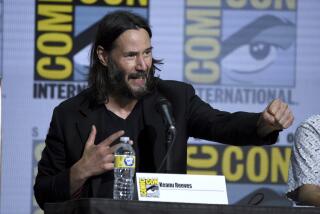So Different, So Much the Same
- Share via
Inside this sprawling, extravagant saga of 22nd century life on a half-destroyed Earth, a modest, understated English novel is whispering politely to be let out.
Ian R. McLeod, a veteran writer of science fiction short stories, has equipped his first book-length tale with the usual technological wonders--robot doctors, designer drugs, a vastly enhanced version of the Internet--and dystopian gloom.
Global warming and nuclear war have turned most of the planet into a poisonous desert with rust-red skies. Only Europe and a few smaller enclaves survive, behind walls of climate control maintained by satellites. On the barely inhabitable North African coast stretches an Endless City peopled by the Borderers, who provide Europe with migrant labor and subsist on its grudging charity.
Languages consist only of “European” and various dialects of Borderer. Government has been replaced by a huge, bureaucratic corporation called Halcycon. Of the world’s great religions, only a watered-down Christianity remains.
Yet in the midst of all this exotica, the plot centers on a comfortingly familiar issue: MacLeod’s hero, English-born Father John Alston, is a priest who is losing his faith.
Alston is spending a year as a missionary in the Endless City. He prays for the poor and doses them with whatever medical supplies he can cadge from the European administrative zone.
Father John notices that many of his parishioners are dying of leukemia. He connects it to their chewing of the koiyl leaf, a mild narcotic resembling coca. With a European-educated Borderer woman, Laurie Kalmar, he journeys to the source of the leaf’s radioactive contamination--a nuclear crater filled with the bones of refugees who, a century before, had tried to flee the deteriorating climate.
Something should be done, Father John thinks. But Halcycon is reluctant to disturb the status quo. Laurie points out that mountain people’s livelihoods depend on koiyl. The distribution of the leaf is hard to trace. Experimenting with it, Father John himself becomes addicted. He has an affair with Laurie and invites censure by the church.
It’s a gentle censure, though, which is characteristic of MacLeod. A vivid stylist, he energetically describes the crumbling warrens of the Endless City and its pagan festivals, but his heart is in his rendering of personal relationships and of aspects of the English countryside that haven’t changed since our time.
Indeed, as we read “The Great Wheel,” a heretical thought keeps occurring: Does it need to be set in the future at all? As ingenious as it is, MacLeod’s vision of the 22nd century is an unlikely one. Couldn’t Graham Greene, given one of his tropical locales, have written a novel half as long that would deal with all the same issues: rich and poor, us and them, blinkered safety and involving risk, the search for God in an apparently godless world?
Some futuristic novels warn us of the outcome of current trends. Others reflect our world back to us so that we see it differently. MacLeod does neither. His future is the same place we know. What it does provide is an outlet for the imagination.
More to Read
Sign up for our Book Club newsletter
Get the latest news, events and more from the Los Angeles Times Book Club, and help us get L.A. reading and talking.
You may occasionally receive promotional content from the Los Angeles Times.










